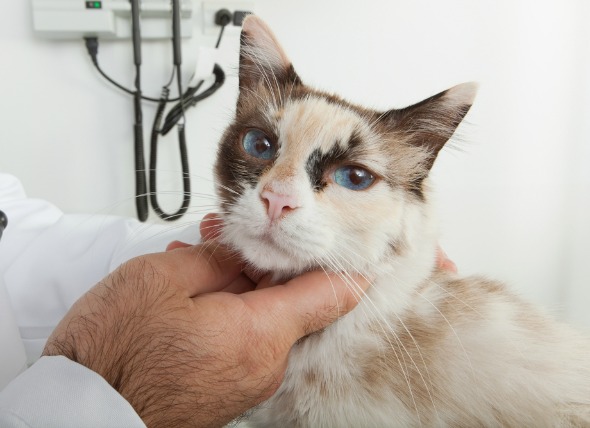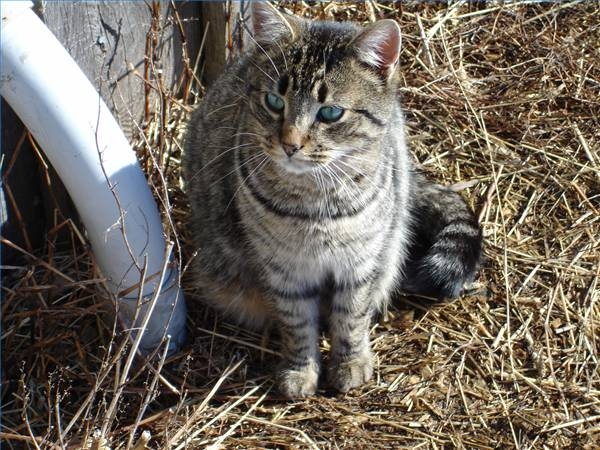

The lower respiratory tract, or lower airways, includes the bronchi, bronchioles, and alveoli. The bronchi begin at the end of the trachea, where they split off into two branches. From there they split off into smaller branches, called the bronchioles. The alveoli are the terminal portion of the lower respiratory tract, within the lungs, where the exchange of oxygen and carbon dioxide takes place.
Bronchitis is the term used to denote inflammation of the bronchi and bronchioles. Chronic bronchitis is a long-standing inflammation of the lower respiratory tract. The condition of asthma includes both sudden (acute) and long-term (chronic) inflammation of the lower airways due to increased sensitivity to various stimuli, including allergens, narrowing of the airways, and an accumulation of specific cells – seen commonly in inflammation and allergic reactions – within these airways. In cats, both acute and chronic inflammation of the lower airways is denoted collectively as feline bronchitis, or feline bronchopulmonary disease (FBD). Chronic inflammation in the lower airways, if left untreated, may leads to fibrosis (excess fibrous tissue in the lungs) and lung atelectasis (a disease in which the lungs are not able to inflate). This disease can occur in cat of any age, but is most common between the ages of 2-8 years.
Due to the acute and chronic nature of this disease, the following symptoms may be seen for variable period of time:
Your veterinarian will perform a thorough physical exam on your pet, taking into account the background history of symptoms and possible incidents that might have precipitated this condition. You will be asked about your cat’s diet, addition of new furniture into the home, and other related questions. An exact cause for this disease is not known, and finding the initiating factor is often a daunting task. Sometimes, something as simple as a new air-freshener is found to be responsible for a sudden episode of this disease, but often the exact cause will remain elusive. After a detailed physical examination has been conducted, treatment for acute cases is started immediately (see Treatment).
In the meantime, your veterinarian will take blood and urine samples for laboratory testing. These blood tests will help to establish the diagnosis, and also to characterize whether the problem is acute or chronic in nature. Fecal samples will also be taken for laboratory examination to see if parasites are present. Your veterinarian may also take samples for bacterial culture to see if infection is involved. X-ray imaging may help in diagnosing the nature, extent, and type of changes in the lung parenchyma (the functional parts of the lung) due to inflammation.
At some hospitals, specific allergy testing facilities are available to find which type of allergen is involved, if any. There are also some specific tests that can be used to take samples from the lungs, which can reveal detailed information about the disease.
In cases of acute asthma episodes, emergency treatment may be required, and if so your cat will be hospitalized until the crisis is over. Oxygen therapy will be started immediately, along with administration of emergency medications to open the airways. Narrowing and constriction of the respiratory passages due to swelling is often present, so your veterinarian will give medicine to relieve the swelling so that your cat can breathe normally. Steroidal medications, and other anti-inflammatory drugs are the most commonly prescribed. After the emergency is over, a future treatment plan will be devised. For some cats, removing the inciting factor is all that is required, but others may need life-long therapy for this condition. This disease can be progressive in nature. If your cat has chronic bronchial problems, your veterinarian will advise long-term medical therapy.
You may need to change your home environment in deference to your cat’s health needs. Air fresheners must be avoided, as well as indoor smoking, chemical sprays, and cat litter that is too fine. There may also be some foodstuffs that will need to be avoided (i.e., ingredients that are added to some cat foods, or table foods). Your veterinarian will advise you on the appropriate foods for your cat and assist you in planning a long-term diet. Also, in chronic cases, you should be mentally prepared for life-long treatment. Talk to your veterinarian in detail and ask questions about things you are not clear about. Recurrence is common and can quickly lead to death unless it is treated promptly. You will need to be especially observant with your cat, so that if you notice it coughing or breathing uneasily, you can treat it with the medicine that has been prescribed, or take it to a veterinary hospital for emergency treatment. Otherwise, follow your veterinarian’s prescribed guidelines concerning diet and dispensation of medicine.
A word of caution: therapy for asthma or bronchitis should never be stopped due to the absence of symptoms.
 Lymph Node Inflammation (Lymphadenitis) in Cats
Lymphadenitis in Cats
Lymphadenitis is a conditio
Lymph Node Inflammation (Lymphadenitis) in Cats
Lymphadenitis in Cats
Lymphadenitis is a conditio
 Constipation (Severe) in Cats
Megacolon in Cats
The colon is the section of lar
Constipation (Severe) in Cats
Megacolon in Cats
The colon is the section of lar
 How Do Cats Communicate?
How Do Cats Communicate?
How Do Cats C
How Do Cats Communicate?
How Do Cats Communicate?
How Do Cats C
 Heart (Aortic) Blood Clot in Cats
Aortic Thromboembolism in Cats
Aortic thromboembo
Heart (Aortic) Blood Clot in Cats
Aortic Thromboembolism in Cats
Aortic thromboembo
 Tumor of the Eye in Cats
Uveal Melanoma in Cats
The uvea is the part of th
Tumor of the Eye in Cats
Uveal Melanoma in Cats
The uvea is the part of th
Copyright © 2005-2016 Pet Information All Rights Reserved
Contact us: www162date@outlook.com